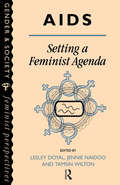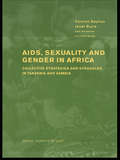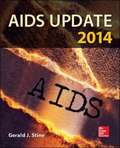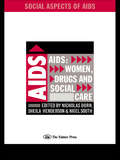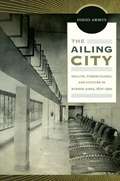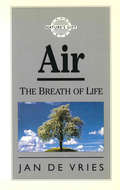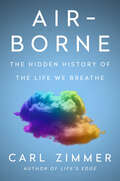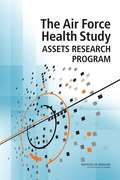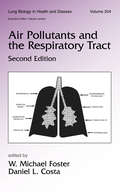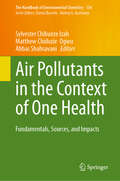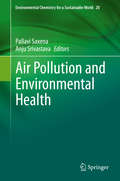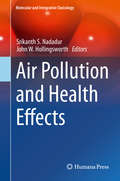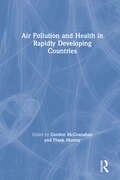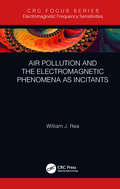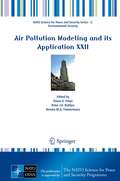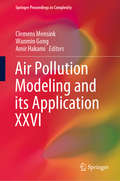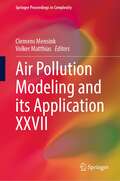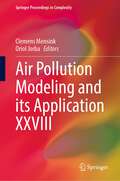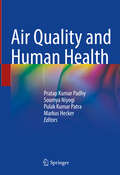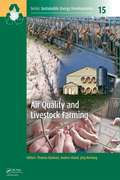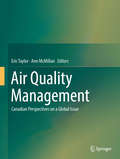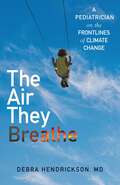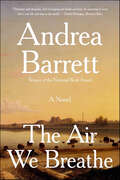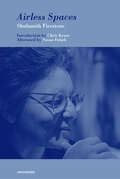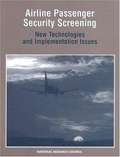- Table View
- List View
AIDS: Setting A Feminist Agenda (Gender And Society Ser.)
by Lesley Doyal Jennie Naidoo Tamsin WiltonAIDS: Setting a Feminist Agenda" presents an overview of the important issues raised for feminist theory and practice by the HIV/AIDS epidemic, and outlines the direction in which feminist debates about the subject are developing. It makes essential links between feminism and HIV/AIDS work, and not only demonstrates that AIDS is a feminist issue, but also suggests areas where feminism is long overdue. The essays discuss medical issues; the specific social and political impact of HIV/AIDS on the lives of women of colour, lesbians, injecting drug users and prostitute women; And Current Health Educational And Health Promotional Practice As It relates to women.; The volume is theoretical and practical - suggesting theoretical models for understanding and challenging the social factors which are conducive to the spread of HIV among women and among men, as well as offering models of good practice for working with and for women.
AIDS Sexuality and Gender in Africa: Collective Strategies and Struggles in Tanzania and Zambia (Social Aspects of AIDS)
by Carolyn Baylies Janet BujraWhile there is a growing list of publications devoted to the AIDS epidemic, Africa, with two-thirds of the world's cases, still receives scant attention. This book may change the way we think about AIDS and how it is being addressed in Africa and the rest of the world.The book draws on first-hand research and in-depth investigations carried out by a team of researchers from Britain, Zambia and Tanzania, and focuses on the gendered aspect of the struggle against AIDS.The authors study the severity of the epidemic and the threat it poses to the population and society in Tanzania and Zambia. They argue that the success of strategies against the spread of AIDS in Africa rests on their recognition of existing gendered power relations and that this success might be enhanced if the strategies are built on existing organisational skills and practices, especially among women. Their conclusions have repercussions for all countries around the world, and especially the rest of Africa.
Aids Update 2014: An Annual Overview of Acquired Immune Deficiency Syndrome
by Gerald J. StineAIDS UPDATE 2014 presents a balanced review of current research and information on HIV infection, HIV disease, and AIDS. AIDS UPDATE 2014 places this discussion within a biological, medical, and social framework. Unique to this textbook is the historical presentation of HIV/AIDS in terms of dates, times, and locations, as well as the meaning of those events in scientific, political, and social terms.
AIDS: Women, Drugs And Social Care (Social Aspects of AIDS #Vol. 1)
by Nicholas Dorn Sheila Henderson Nigel SouthExamines the circumstances, experiences and needs of HIV-positive people in Britain and Ireland, and particularly focuses on female drug-users and ex drug-users.
The Ailing City: Health, Tuberculosis, and Culture in Buenos Aires, 1870-1950
by Diego ArmusFor decades, tuberculosis in Buenos Aires was more than a dangerous bacillus. It was also an anxious state of mind shaped not only by fears of contagion and death but also by broader social and cultural concerns. These worries included changing work routines, rapid urban growth and its consequences for housing and living conditions, efforts to build a healthy "national race," and shifting notions of normality and pathology. In The Ailing City, the historian Diego Armus explores the metaphors, state policies, and experiences associated with tuberculosis in Buenos Aires between 1870 and 1950. During those years, the disease was conspicuous and frightening, and biomedicine was unable to offer an effective cure. Against the background of the global history of tuberculosis, Armus focuses on the making and consolidation of medicalized urban life in the Argentine capital. He discusses the state's intrusion into private lives and the ways that those suffering from the disease accommodated and resisted official attempts to care for them and to reform and control their morality, sociability, sexuality, and daily habits. The Ailing City is based on an impressive array of sources, including literature, journalism, labor press, medical journals, tango lyrics, films, advertising, imagery, statistics, official reports, and oral history. It offers a unique perspective on the emergence of modernity in a cosmopolitan city on the periphery of world capitalism.
Air: The Breath of Life (Nature's Gift Ser.)
by Jan de VriesPollution is an ever-growing threat to our planet and manifests itself most dramatically in its impact on the natural environment which surrounds us. But just as trees are dying daily because of environmental pollution, so too are humans suffering. Air pollution has led directly to an increase in asthma, bronchitis and other related respitory complaints. In Air: The Breath of Life, Jan de Vries calls upon his vast experience in dealing with respiratory problems to guide his readers on how best to assist our own immune system in combating the worst effects of pollution.
Air-Borne: The Hidden History of the Life We Breathe
by Carl ZimmerThe fascinating, untold story of the air we breathe, the hidden life it contains, and invisible dangers that can turn the world upside downEvery day we draw in two thousand gallons of air—and thousands of living things. From the ground to the stratosphere, the air teems with invisible life. This last great biological frontier remains so mysterious that it took over two years for scientists to finally agree that the Covid pandemic was caused by an airborne virus.In Air-Borne, award-winning New York Times columnist and author Carl Zimmer leads us on an odyssey through the living atmosphere and through the history of its discovery. We travel to the tops of mountain glaciers, where Louis Pasteur caught germs from the air, and follow Amelia Earhart and Charles Lindbergh above the clouds, where they conducted groundbreaking experiments. We meet the long-forgotten pioneers of aerobiology including William and Mildred Wells, who tried for decades to warn the world about airborne infections, only to die in obscurity.Air-Borne chronicles the dark side of aerobiology with gripping accounts of how the United States and the Soviet Union clandestinely built arsenals of airborne biological weapons designed to spread anthrax, smallpox, and an array of other pathogens. Air-Borne also leaves readers looking at the world with new eyes—as a place where the oceans and forests loft trillions of cells into the air, where microbes eat clouds, and where life soars thousands of miles on the wind.Weaving together gripping history with the latest reporting on Covid and other threats to global health, Air-Borne surprises us on every page as it reveals the hidden world of the air.
The Air Force Health Study Assets Research Program
by Committee on the Management of the Air Force Health Study Data Specimens--Report to CongressThe Air Force Health Study (AFHS) is a longitudinal, prospective epidemiologic study of more than 2,700 men followed for approximately 20 years. This cohort participated in up to six intensive physical examinations with high rates of compliance. In addition to a complete record of clinical measurements and observations collected at these exams, serum and other biological samples were obtained and preserved. Extensive questionnaires addressing health, lifestyle, and socioeconomic status were administered during each exam, and other information was obtained about the participants' employment, families and offspring, and potential sources of environmental exposures. While the study was completed in 2006, the extensive health data linked to several types of longitudinally collected biologic specimens - some 91,000 serum, whole blood, urine, semen, and adipose tissue specimens - remain a resource for additional research. The AFHS assets are exceptional in the sheer multitude and range of types of information available for each participant. The longitudinal nature of the AFHS - with its extended follow-up, high rates of retention, and repeat biological samples - provides a valuable opportunity for research beyond the original aims of the study. Currently, the Institute of Medicine is the custodian of these assets. "The Air Force Health Study Assets Research Program" outlines the feasibility and advisability of maintaining the biospecimens based on interest generated from the general scientific community and results of pilot projects and other research projects using the AFHS assets. According to this report, sustaining access to the AFHS biospecimens and data benefits the veterans community and the public at large, who will gain from the information derived from studies of the assets. . This report discusses the scientific value of the AFHS data and biospecimens and the lessons learned in managing access to the assets.
Air Pollutants and the Respiratory Tract
by W. Michael Foster Daniel L. CostaEmphasizing the impact of air toxins and contaminants on human health, this Second Edition examines the latest research from the epidemiology to the cellular mechanisms underlying cardiopulmonary responses to air pollution. This guide offers chapters that address the basic biology, techniques, and clinical practices used to monitor and assess acute
Air Pollutants in the Context of One Health: Fundamentals, Sources, and Impacts (The Handbook of Environmental Chemistry #134)
by Sylvester Chibueze Izah Matthew Chidozie Ogwu Abbas ShahsavaniThis book reviews air pollutants and their effects on human health, biodiversity, and environmental quality in the context of the One Health framework. Written by experts in the field, the book covers topics such as natural and anthropogenic sources of air pollutants, air pollutants classification based on their chemical composition, physical properties, and origins, and consequences of air pollution on ecosystems, wildlife, and human communities. In this book, readers will find a detailed examination of pollutants, such as particulate matter, volatile organic compounds, and greenhouse gases, and will learn about the mechanisms by which pollutants impact, for instance, the respiratory, cardiovascular, and neurological systems. The book highlights the need for understanding the different pollutants and their One Health effects as a foundation for developing effective regulations, emission controls, cleaner technologies, and promoting lifestyle changes. The book also offers a global perspective on air pollution, and discusses the disproportionate impacts of air pollution on vulnerable populations. In alignment with the United Nations Sustainable Development Goals (SDG), specifically SDG 3 (Good Health and Well-being), SDG 7 (Affordable and Clean Energy), and SDG 11 (Sustainable Cities and Communities), this book takes a focused approach to the One Health implications of various air pollutants and is an important contribution to the global effort to mitigate the impact of air pollution on human health, biodiversity security, and environmental quality. Together with its companion work “Sustainable Strategies for Air Pollution Mitigation”, this book is a valuable resource for students, researchers, policymakers, and anyone seeking a comprehensive perspective on this critical environmental and public health challenge.
Air Pollution and Environmental Health (Environmental Chemistry for a Sustainable World #20)
by Pallavi Saxena Anju SrivastavaAir pollution is an alarming problem, not only in terms of air quality, but also in relation to health issues. Toxic air pollutant concentrations produce harmful impacts on plant health and human health. Further, though there are various sources of air pollution, anthropogenic and biogenic sources are becoming increasingly problematic. A number of control methods have been applied to reduce the air pollutant concentrations so that their global environmental burden on plants as well as humans can be mitigated. However, as confirmed in numerous reports and studies, their concentrations continue to be very high and everyday cases related to air pollution have become exponentially high not only in developing countries but also in developed countries. In plants, toxic air quality has various adverse effects, including biochemical and physiological disorders, chronic diseases and/or lower yields. In humans, air pollutants affect the body’s metabolism and immune system, lungs and central nervous system. This book provides an essential overview of air pollution, its impacts on plant and human health, and potential control strategies. The respective chapters cover general monitoring and characterization techniques for air pollutants, air quality modelling applications, plant and human health effects, risk assessment, and air pollution control policy. Given its scope, the book offers a valuable and unique resource for students of Environmental Science, Biological Science, Medical Science and Agriculture; and for environmental consultants, researchers and other professionals whose work involves air quality, plant and human related research.
Air Pollution and Health Effects (Molecular and Integrative Toxicology)
by Srikanth S. Nadadur John W. HollingsworthExposure to ambient air pollutants, both indoors and outdoors has been associated with the exacerbation and also in the etiology of diverse human diseases. This book offers an overview of our current understanding of air pollution health risks and how this knowledge is being used in the regulatory, therapeutic intervention measures to protect the public health and reduce the disease burden caused by acute and long-term exposure to air pollutants. Air Pollution and Health Effects provides readers with a comprehensive understanding of air pollution health risks, morbidity and the global disease burden, whilst also delivering critical review on state of the art research so as to gain a fundamental understanding of the biological mechanisms involved in the etiology of air pollution-induced diseases. Chapters range from pregnancy outcomes and pre-term birth, carcinogens in the ambient aerosol and the health consequences of indoor biomass burning. Special emphasis is placed on regional and local air pollution and its impact on global health along with suitable preventive and interventional measures. With contributions from international experts in the field this volume is a valuable guide for researchers and clinicians in toxicology, medicine and public health as well as industry and government regulatory scientists involved in health protection.
Air Pollution and Health in Rapidly Developing Countries
by Gordon McGranahan Frank MurrayIn developing countries the price of rapid growth is all too often noxious airborne pollution, which annually contributes to a disturbing number of avoidable deaths. In recent decades, however, there has been considerable progress in the epidemiology of air pollution, significant changes in international air pollution guidelines, and the emergence of more systematic approaches to air pollution control. While many of these advances have originated in affluent countries, there have been major developments in other parts of the world. In this book, a distinguished cast of leading researchers in both the scientific and policy dimensions of air pollution and health have synthesized the recent developments in the field and their relevance for public health in developing countries. The authors review studies from a wide range of Asian, African and Latin American countries and contrast the findings with those from Europe and North America. They also describe various tools and systems for air pollution management and emphasize approaches that can be used when data is scarce. With a clear focus on the scientific and technical aspects of air pollution and health, this book is essential reading for pollution and health policy-makers, researchers and others concerned with air pollution and health in developing countries.
Air Pollution and the Electromagnetic Phenomena as Incitants (Electromagnetic Frequency Sensitivities)
by William J. ReaThe field of electromagnetic sensitivity is the new epidemic of the 21st century, and can cause disease of the automatic nerve system in any part of the body. This is as a result of chemical sensitivity, in which over 80,000 chemicals are involved, resulting in innumerable combinations. A cursory understanding of the combinations can help clinicians partially understand the associated problems and thus help in the diagnosis and treatment of electromagnetic sensitivities. But a basic understanding of environmentally induced illness and healing must first be understood by the clinicians before diseases occur such as cardiac arrhythmia, muscle spasms, and nerve pain.
Air Pollution Modeling and its Application XXII (NATO Science for Peace and Security Series C: Environmental Security)
by Douw G. Steyn Peter J.H. Builtjes Renske M.A. TimmermansRecent developments in air pollution modeling and its application are explored here in contributions by researchers at the forefront of their field. The book is focused on local, urban, regional and intercontinental modeling; data assimilation and air quality forecasting; model assessment and evaluation; aerosol transformation; the relationship between air quality and human health and the interaction between climate change and air quality. The work will provide useful reference material for students and professors interested in air pollution modeling at the graduate level as well as researchers and professionals involved in developing and utilizing air pollution models.
Air Pollution Modeling and its Application XXVI (Springer Proceedings in Complexity)
by Clemens Mensink Wanmin Gong Amir HakamiCurrent developments in air pollution modeling are explored as a series of contributions from researchers at the forefront of their field. This newest contribution on air pollution modeling and its application is focused on local, urban, regional and intercontinental modeling; emission modeling and processing; data assimilation and air quality forecasting; model assessment and evaluation; atmospheric aerosols. Additionally, this work also examines the relationship between air quality and human health and the effects of climate change on air quality.This work is a collection of selected papers presented at the 36th International Technical Meeting on Air Pollution Modeling and its Application, held in Ottawa, Canada, May 14-18, 2018.The book is intended as reference material for students and professors interested in air pollution modeling at the graduate level as well as researchers and professionals involved in developing and utilizing air pollution models.
Air Pollution Modeling and its Application XXVII (Springer Proceedings in Complexity)
by Clemens Mensink Volker MatthiasThis book is intended as reference material for students and professors interested in air pollution modeling at the graduate level as well as researchers and professionals involved in developing and utilizing air pollution models. Current developments in air pollution modeling are explored as a series of contributions from researchers at the forefront of their field. This newest contribution on air pollution modeling and its application is focused on local, urban, regional and intercontinental modeling; emission modeling and processing; data assimilation and air quality forecasting; model assessment and evaluation; aerosol transformation. Additionally, this work also examines the relationship between air quality and human health and the effects of climate change on air quality.This work is a collection of selected papers presented at the 37th International Technical Meeting on Air Pollution Modeling and its Application, held in Hamburg, Germany, September 23-27, 2019.
Air Pollution Modeling and its Application XXVIII (Springer Proceedings in Complexity)
by Clemens Mensink Oriol JorbaThis book states that current developments in air pollution modeling are explored as a series of contributions from researchers at the forefront of their field. This newest contribution on air pollution modeling and its application is focused on local, urban, regional and intercontinental modeling; long-term modeling and trend analysis; data assimilation and air quality forecasting; model assessment and evaluation; aerosol transformation. Additionally, this work also examines the relationship between air quality and human health and the effects of climate change on air quality.This work is a collection of selected papers presented at the 38th International Technical Meeting on Air Pollution Modeling and its Application, held in Barcelona, Spain, Oct 18–22, 2021. The book is intended as reference material for students and professors interested in air pollution modeling at the graduate level as well as researchers and professionals involved in developing and utilizing air pollution models.
Air Quality and Human Health
by Markus Hecker Pratap Kumar Padhy Soumya Niyogi Pulak Kumar PatraThe book is one of the outcomes of the SPARC (Scheme for Promotion of Academic and Research Collaboration) project titled "Fine particulates matters in the air environment and their cancer risks in human beings," sponsored by MHRD (now MoE), Govt. of India. The editors of the book are PIs and Co-PIs of the said project. The text deliberates on air pollution's health risks with contributions from well-known experts from diverse research fields (environmental science, toxicology, geology, public health science, biology, physics, chemistry, and geospatial technology). It explores it its control and mitigation strategies. The book provides an up-to-date overview of the modern methods and tools used in air quality monitoring and human health risk assessment. Case studies from different global settings offer invaluable insights into air pollution-related regional health issues. It addresses all aspects of air quality, covering indoor-outdoor air pollution, gaseous and particulate pollutants; characterization of source and pathways of air pollutants; and the modeling and assessing of health risks (respiratory, epidemiological, and toxicological) with regional and global perspectives. It also addresses air quality management issues. The lucid explanation of the role of oxidative stress mechanisms and molecular biomarkers (genomics, proteomics) may be considered as inputs into the development of cancer therapeutics. Along with providing a scientific basis for air pollution, this book will help readers appreciate the environmental determinants of public health and apply research evidence to improve the quality of life. It also delineates future research initiatives and policy actions needed to protect human health from air pollution, locally and globally. The book will be of great educational value and help for consultation and teaching.
Air Quality and Livestock Farming (Sustainable Energy Developments)
by Thomas Banhazi Andres Aland Jörg HartungAir quality has a direct influence on health, welfare and production performance of livestock as the high concentrations of noxious gases, dust and airborne microorganisms are likely to reduce production efficiency and the general welfare of farm animals. Long term exposure to particulates in livestock buildings might also affect the respiratory health of farm workers. Dust in animal buildings contains many biologically active substances such as bacteria, fungi, endotoxins and residues of antibiotics (as a result of veterinary treatments) that are suspected to be hazardous to human health. Furthermore, air pollutants emitted from livestock buildings can reduce air, water and soil quality and can potentially undermine the health of nearby residents. Airborne emissions include ammonia, methane, nitrous oxide, particulates like dust and microorganisms. In addition, other potentially harmful substances such as heavy metals, antibiotic residues and components of disinfectants might be also emitted from livestock building that are potentially damaging to ecosystems. In this book, key aspects of agricultural air quality, such as monitoring, managing and reducing airborne pollutants in and around livestock facilities are reviewed. Features: addressing the raising awareness of the importance of optimal health and welfare for lifestock species with contributions from international specialists and researchers providing up-to-date information for professionals involved in modern animal producti This book will be useful for farming professionals, academics, students, policy makers, business leaders, regulatory bodies and agricultural consultants.
Air Quality Management: Canadian Perspectives on a Global Issue
by Ann Mcmillan Eric TaylorThis book provides a wide overview of the issues related to managing of air quality in Canada. Learn about the air issues that have caused impacts to ecosystems or human health and hence been targeted to be managed. Discover how Canada's national governance involving a federal government along with provincial and territorial governments impacts the air quality management process. Understand how Canadians manage their air quality in context with the USA, their largest and closest neighbour. Benefit from the experience of 43 of Canada's most experienced air quality management professionals who share their insights into the state of air quality in Canada today, how it is managed, as well as giving a glimpse into the future.
The Air They Breathe: A Pediatrician on the Frontlines of Climate Change
by Debra HendricksonA timely, revelatory first look into the impact climate change has on children—the greatest moral crisis humanity faces today—by a pediatrician in the fastest warming city in America.Wildfires, hurricanes, and heat waves make headlines. But what is happening in Debra Hendrickson&’s clinic tells another story of this strange and unsettling time. Hendrickson is a pediatrician in Reno, Nevada—the fastest warming city in the United States, where ash falls like snow during summer wildfires. In The Air They Breathe, Dr. Hendrickson recounts patients she&’s seen who were harmed by worsening smoke, smog, and pollen; two boys in Arizona, stricken by record-setting heat while hiking; children who fled for their lives from Hurricane Harvey and the Tubbs Fire; and a little girl whose life was forever altered by the Zika virus outbreak in 2016. The climate crisis is a health crisis, and it is a health crisis, first and foremost, for children. Children&’s bodies are interwoven with and shaped by their surroundings. As the planet warms and their environment changes, children&’s health is at risk. The youngest are especially vulnerable because their brain, lungs, and other organs are forming and growing every day, and because their physiology is so different from that of adults. Childhood has always been a risky period of life; throughout history, babies and children have met peril, from polio to famine, from cyclones to war. Yet they have never quite had to face, in quite this way, the potential loss of the future itself. The Air They Breathe is not just about the health impacts of global warming, but something more: a soul-stirring reminder of our moral responsibility to our children, and their profound connections to this unique and irreplaceable world.
The Air We Breathe: A Novel
by Andrea Barrett"Turbulent and dramatic, full of longing and death and lust, the yearning to cover one’s own life and way in the world." —David Mehegan, Boston Globe An elegant and astute tale of desire and betrayal, science and medicine, from the "genius enchantress" (Karen Russell) author of Ship Fever, winner of the National Book Award.In the fall of 1916, America prepares for war—but in the town of Tamarack Lake, the focus is on the sick. Wealthy tubercular patients live in private cure cottages; charity patients, mainly immigrants, fill the large public sanatorium. From within their isolated community, they grapple with some of the most thrilling scientific discoveries of their time—X-ray technology, chemical and biological weapons, changing theories of atomic structure—and their limitations. Prisoners of routine, they take solace in gossip, rumor, and, sometimes, secret attachments. When the well-meaning efforts of one enterprising patient lead instead to a tragic accident and a terrible betrayal, the war comes home, bringing with it a surge of anti-immigrant prejudice. With The Air We Breathe, Andrea Barrett has crafted a "majestic, breathtaking, [and] thrilling" (San Diego Union-Tribune) novel that brilliantly illuminates the inescapable heartbreak of war.
Airless Spaces, new edition (Semiotext(e) / Native Agents)
by Shulamith FirestoneShort stories set among the disappeared and darkened sectors of New York City, about characters who fall prey to an increasingly bureaucratized poverty.After they raised her dose to 42 mg. of Trilafon, Lucy very nearly fainted. She felt a rush of bad sensation comparable to her mental telepathy when her grandmother died ... But there was a good aspect to fainting too. As she was about to lose consciousness, she felt an overwhelming relief. The black velvety edges of the swoon. If only she could faint all the way, black out, and never wake up again ...Shulamith Firestone was twenty-five years old when she published The Dialectic of Sex, her classic and groundbreaking manifesto of radical feminism, in 1970. Disillusioned and burned out by the fragmented infighting within the New York City radical feminist groups she&’d helped to found, when her book hit the bestseller lists, Firestone decided against pursuing a career as a &“professional feminist.&” Instead, she returned to making visual art, the profession that she&’d trained for. She wouldn&’t publish anything again until Airless Spaces, in 1998.Long before her first hospitalization for paranoid schizophrenia in 1987, Firestone had fallen off the grid and into precarity and poverty. For the next decade, she would move in and out of public psychiatric wards and institutions. Conceived as a series of vignettes about institutions and identity, Airless Spaces is a subtle and deeply literary work. Embedded as a participant-observer, Firestone moves beyond the spectacular and frightening surfaces of institutional life to record individual lives and acts of cruelty and kindness. The existence that she depicts is a microcosm of the world beyond.
Airline Passenger Security Screening: New Technologies and Implementation Issues
by Panel on Passenger ScreeningThis book addresses new technologies being considered by the Federal Aviation Administration (FAA) for screening airport passengers for concealed weapons and explosives. The FAA is supporting the development of promising new technologies that can reveal the presence not only of metal-based weapons as with current screening technologies, but also detect plastic explosives and other non-metallic threat materials and objects, and is concerned that these new technologies may not be appropriate for use in airports for other than technical reasons. This book presents discussion of the health, legal, and public acceptance issues that are likely to be raised regarding implementation of improvements in the current electromagnetic screening technologies, implementation of screening systems that detect traces of explosive materials on passengers, and implementation of systems that generate images of passengers beneath their clothes for analysis by human screeners.
